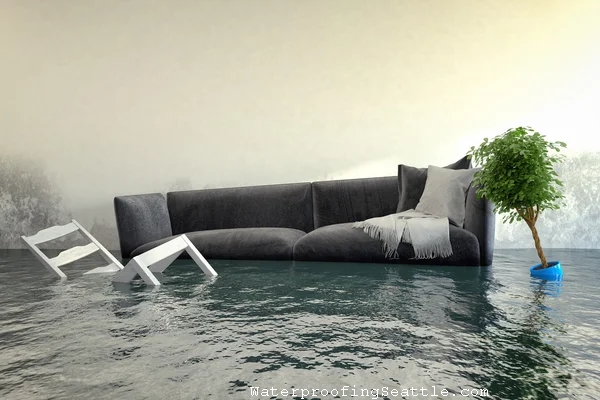
Welcome to Storm Season Preparedness: A King County Washington Homeowner’s Guide to Water Damage Prevention. As homeowners in this beautiful region, we understand the importance of safeguarding our homes and belongings from the unpredictable storms that can come our way. Don’t wait until it’s too late! Take action now to prevent water damage and protect what matters most to you.
Are you ready to be proactive and prepared? Here are seven essential steps every homeowner should take:
1. Check your gutters and downspouts. Make sure they are clear of any debris, such as leaves and branches. Clogged gutters can cause water to overflow and seep into your home’s foundation. Don’t let a simple task like gutter cleaning become a costly water damage repair.
2. Inspect your roof for any signs of damage or wear. High winds, heavy rain, and falling branches can compromise the integrity of your roof, leading to leaks and water intrusion. Don’t ignore that missing shingle or cracked tile ” address it now before the storm hits.
3. Seal any gaps or cracks around windows and doors. These small openings may seem insignificant, but they can allow water to seep into your home during a storm. By sealing them with weatherstripping or caulk, you can prevent water damage and keep your home dry.
4. Install a sump pump in your basement or crawl space. When heavy rainfall occurs, these low-lying areas are particularly vulnerable to flooding. A sump pump can quickly and efficiently remove excess water, providing you with peace of mind and minimizing the risk of water damage.
5. Elevate your appliances, furniture, and valuables. If your home is prone to flooding, consider raising these items off the ground or moving them to a higher level. This simple step can help protect your belongings and reduce the impact of water damage.
6. Create a household emergency plan. Know the safest areas in your home and establish a communication plan with your family members. It’s essential to stay connected during a storm and be prepared for any unexpected events that may arise. Remember, preparedness is key.
7. Consult with a professional water damage restoration company. Even with the best precautions in place, accidents can still happen. By having a reputable professional on standby, you can ensure quick and effective water damage recovery should the need arise.
Roofs and Gutters: Safeguarding Your Home’s First Line of Defense
When it comes to protecting your home from water damage, your roof and gutters are the first line of defense. Take a proactive approach to maintain and safeguard these crucial components:
Regularly inspect your roof for any signs of damage or wear. Look for missing or damaged shingles, cracked tiles, or sagging areas. Address any issues promptly to prevent water intrusion during a storm.
Clean your gutters and downspouts at least twice a year, or more frequently if you have a lot of trees near your property. Remove any debris that may clog the gutters and prevent water from draining properly.
Consider installing gutter guards to prevent leaves and other debris from accumulating in your gutters. This can significantly reduce the amount of maintenance required and help ensure that water flows freely away from your home.
Trim branches that overhang your roof or gutters. During a storm, these branches can be dislodged and cause damage to your roof. By proactively managing your landscaping, you can minimize the risk of roof-related water damage.
Protecting Your Home: Sealing Doors, Windows, and Foundation Cracks
Water can find its way into your home through even the smallest gaps and cracks. Take these preventative measures to keep water out:
Inspect the seals and weatherstripping around your doors and windows. Replace any worn or damaged weatherstripping, and reseal any gaps or cracks with caulk. By creating a tight seal, you can prevent water infiltration during a storm.
Check the foundation of your home for any cracks or gaps. Seal them using a waterproof sealant to prevent water from seeping into your basement or crawl space. Being proactive now can save you from costly water damage repairs later.
Consider installing window well covers. These protective barriers prevent water from entering your basement through window wells, reducing the risk of flooding and water damage. Now is the time to take action and safeguard your home.
Basement and Crawl Space: Waterproofing for Added Protection
Basements and crawl spaces are especially susceptible to water damage, making waterproofing an essential step in storm season preparedness:
Install a sump pump in your basement or crawl space. This device is designed to remove excess water, preventing flooding and water damage. Regularly check that it is functioning correctly and has a backup power source in case of a power outage.
Insulate your basement or crawl space walls. This not only helps regulate temperature but also acts as a moisture barrier, reducing the risk of water intrusion. Insulation is a cost-effective way to add an extra layer of protection to your home.
Ensure proper ventilation in your basement or crawl space. Good airflow helps reduce moisture buildup and prevents mold growth. Consider installing vents or dehumidifiers to maintain optimal humidity levels.
Waterproof your basement or crawl space by applying a waterproof sealant to the walls and floors. This extra layer of protection can significantly reduce the risk of water damage and provide peace of mind during storm season.
